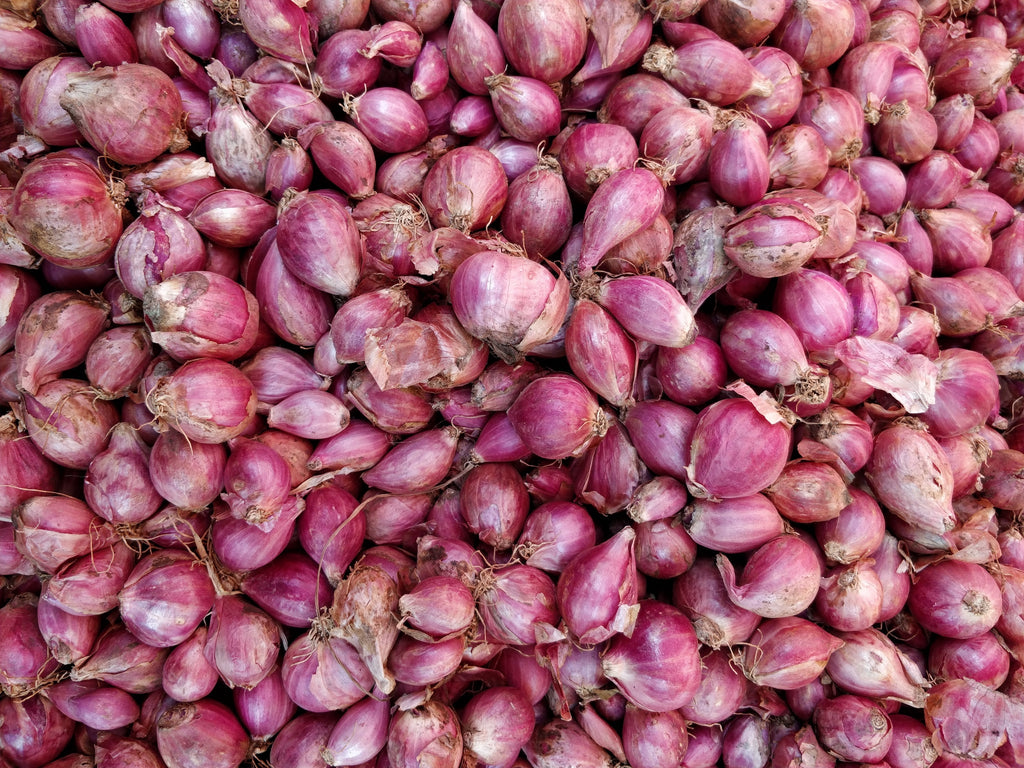Many folks have never eaten Shallots, and probably a good number of them have never even heard of them. However, in Europe and within many epicurean circles the world over, they are adored for the subtle flavors they impart savory dishes. Shallots are thought to have been brought to Europe from the Middle East (more specifically the Zagros mountains of present day Iran & Iraq) by returning Crusaders and later popularized by Charles the Great, aka Emperor Charlemagne in early 9th century CE.
Though a staple in French cooking, shallots are thought to have been brought to Europe from Asia. Prized around the world for their delicate and complex flavor. Cuisines that regularly call for shallots include Sri Lanka, India, Kashmir, Nepal, Persia and many South-East Asian countries.

Technically shallots are botanical cultivar of onions and they can actually cross pollinate with onion flowers if left to flower. The term shallot is usually applied to the French red shallot (Allium cepa var. aggregatum, or the A. cepa Aggregatum Group). Their growth habit differs from onions that tend to form one large bulb, shallots divide into “cloves”, similar to garlic or daffodils.


Fried shallots, called "bawang goreng" in Indonesia
The flavor is spicy sharp when raw, but mellows wonderfully when sauteed. A sublime ingredient that can underpin many a divine savory dish! Shallots pickled in red vinegar are common in many Indian restaurants, served along with sauces. In Kashmir shallots are widely used in preparation of Wazwan Kashmiri cuisine, as they add distinct flavor and prevent curry from becoming black, which is common with onions. Crispy shallot chips are also used in southern Chinese cuisine. In Indonesia, shallots are sometimes made into pickles that are added to several traditional foods; the pickles' sourness is thought to increase the appetite.

Growing Shallots:
Bulbs are best Fall planted at the same time that you might plant garlic which for us here in Western Oregon is in October. If you acquire bulbs from us (or anywhere else), then you would divide the individual cloves and plant each one at a 12” spacing into well prepared garden beds that were amended with plenty of compost to ensure ample fertility. Similar to growing onions or garlic, ensuring adequate soil fertility is very important, as they do not have extensive root systems and need the nutrients right where they are growing. One of my early farming mentors shared the adage that applies equally to shallots on account of their inefficient root system, ”that you can grow garlic, or you can grow weeds, but you can’t grow both.”

They will grow a mound of tubular leaves akin to onions over the winter and then begin bulbing in late spring as lengthening days approach the summer solstice. They can be harvested at any point once the bulbs begin to form papery skins, which occurs in mid-August for us here in Oregon).. Post-harvest they should be cured in a shady place like a garage or shed, then tops and roots trimmed off. They will store in typical shed conditions for 6 months. You can save some of your harvest for replanting in the Fall.
While French Gray Shallots can only be grown from bulb divisions, the golden types can be grown from seed, in which case you would plant them in February or March like onions and grow accordingly, harvesting in August and curing as above.
Bulb size is 1/2"-2" with typically 20-30 per pound.


Jennifer
Just finished cleaning my French red and French grey crops (first time planting them). Have never used grey before in my cooking – and the cloves are somewhat small. Do you have guidance on how to prep them – maybe just leave them whole or halve them 🤔 The red are plump and a good deal larger.
Thanks for the timely post! (Margaret Roach’s current podcast is about shallots this week, too!)